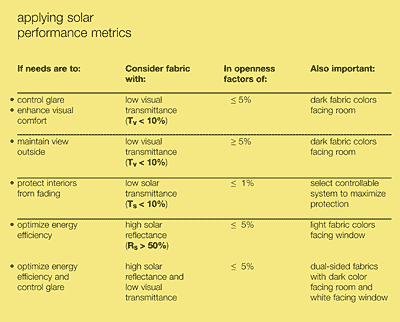Daylight in the Office Space
Color
While shades are available in virtually any color, from charcoal or blue, to pink or sand, the behavior of the fabric in the presence of sunlight is determined by whether the fabric is considered light or dark.
Light-colored fabrics absorb little light energy and are highly reflective. This high solar reflectance (Rs), coupled with low solar absorptance (As), makes light-colored fabrics well equipped to combat solar heat gain. Since very little heat is absorbed, there is little risk that a light-color shade will become its own separate heat radiator.
While much of a fabric's solar transmittance (Ts) is determined by openness factor, color does affect the visual transmittance (Tv) or glare-reducing capabilities of the shade. Light colors have a higher visual transmittance value, which means they are less adept at reducing glare. When solar energy hits a light-colored shade, some energy is reflected, some is transmitted into the space, some is absorbed into the fabric, and some light is trapped inside the weave, not absorbed. This trapped light bounces around in the shade itself, making light-colored shades bright to look at and difficult to look through. For these reasons, light-colored shades are not the most effective at reducing glare or preserving an outdoor view.
|
||||||||||||||
Dark-colored fabrics are highly absorbent. These higher solar absorptance (As) values combine with lower solar reflectance (Rs) values to create a fabric body that will absorb significant amounts of solar radiation, essentially becoming its own heat radiator. When a screen is placed inside a window, the heat absorbed by the fabric is added to the heat transmitted. This characteristic makes dark fabric a less appealing project choice if the most important goal in the space is controlling solar heat gain.
Dark fabrics have lower visual transmittance (Tv) values, indicating that they are highly capable of reducing the glare-causing light in an application and providing a clear view to the outdoors. As solar energy touches a shade, it is either reflected, absorbed, transmitted, or trapped within the weave. The absorbent nature of the dark fabric allows much less light to bounce around before being absorbed, causing little visual distraction.
Dual-sided fabrics that effectively combat solar heat gain, while reducing glare and maintaining a view to the outdoors, are available. These fabrics provide a "best of both worlds" solution with a light color facing the exterior of the building to reflect heat energy, and a dark color facing the interior to effectively absorb or diffuse glare-causing light and provide outdoor views.










